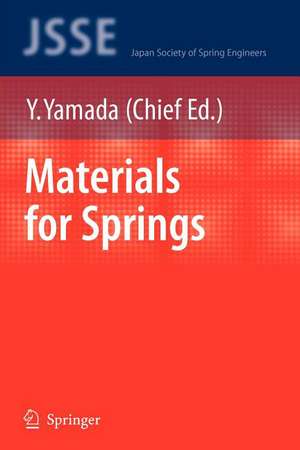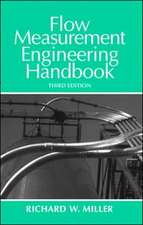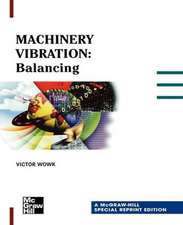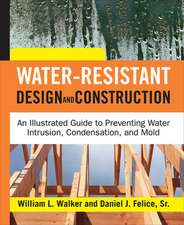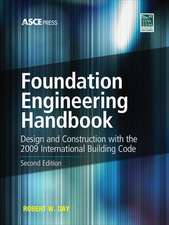Materials for Springs
Yoshiro Yamada Toshio Kuwabaraen Limba Engleză Paperback – 19 apr 2011
| Toate formatele și edițiile | Preț | Express |
|---|---|---|
| Paperback (1) | 949.23 lei 6-8 săpt. | |
| Springer Berlin, Heidelberg – 19 apr 2011 | 949.23 lei 6-8 săpt. | |
| Hardback (1) | 952.89 lei 6-8 săpt. | |
| Springer Berlin, Heidelberg – 11 sep 2007 | 952.89 lei 6-8 săpt. |
Preț: 949.23 lei
Preț vechi: 1157.60 lei
-18% Nou
Puncte Express: 1424
Preț estimativ în valută:
181.66€ • 188.95$ • 149.97£
181.66€ • 188.95$ • 149.97£
Carte tipărită la comandă
Livrare economică 14-28 aprilie
Preluare comenzi: 021 569.72.76
Specificații
ISBN-13: 9783642093036
ISBN-10: 3642093035
Pagini: 396
Ilustrații: XV, 377 p. 336 illus.
Dimensiuni: 155 x 235 x 21 mm
Greutate: 0.55 kg
Ediția:Softcover reprint of hardcover 1st ed. 2007
Editura: Springer Berlin, Heidelberg
Colecția Springer
Locul publicării:Berlin, Heidelberg, Germany
ISBN-10: 3642093035
Pagini: 396
Ilustrații: XV, 377 p. 336 illus.
Dimensiuni: 155 x 235 x 21 mm
Greutate: 0.55 kg
Ediția:Softcover reprint of hardcover 1st ed. 2007
Editura: Springer Berlin, Heidelberg
Colecția Springer
Locul publicării:Berlin, Heidelberg, Germany
Public țintă
Professional/practitionerDescriere
Materials for springs is basically intended for engineers related to spring materials and technologies who graduated from metallurgical or mechanical engineering courses in technical high school, or in other higher engineering schools, as well as those who are related to the purchase or sales of spring materials.
The first chapter introduces into the fundamental selection processes of spring materials including the information sources on materials database. It is followed by the basic mechanisms and theories of spring failures such as fatigue fracture, creep/stress relaxation and stress corrosion cracking of metallic materials.
The focuses of the second chapter is put on ferrous and non-ferrous metallic materials, including some materials developed in these two decades, such as high strength automobile suspension steels etc.
In the third and fourth chapters, polymer materials, FRP (Fiber Reinforced Plastics), ceramics and C/C composite materials are the main subject respectively.
In the fifth chapter, lists of Japanese spring material manufacturers and their material grades being produced, comparisons of spring materials in the Japanese Industrial Standards with some other foreign standards, etc, are summarized.
The first chapter introduces into the fundamental selection processes of spring materials including the information sources on materials database. It is followed by the basic mechanisms and theories of spring failures such as fatigue fracture, creep/stress relaxation and stress corrosion cracking of metallic materials.
The focuses of the second chapter is put on ferrous and non-ferrous metallic materials, including some materials developed in these two decades, such as high strength automobile suspension steels etc.
In the third and fourth chapters, polymer materials, FRP (Fiber Reinforced Plastics), ceramics and C/C composite materials are the main subject respectively.
In the fifth chapter, lists of Japanese spring material manufacturers and their material grades being produced, comparisons of spring materials in the Japanese Industrial Standards with some other foreign standards, etc, are summarized.
Cuprins
A Guide to Spring Material Selection.- Metallic Material for Springs.- Polymeric Materials.- Inorganic Materials.
Notă biografică
Dr. Yoshiro Yamada:
- Master of Engineering Degree from the Graduate School of Osaka University in 1966
- Doctor of Engineering Degree from the same university in 1976
- Japanese Professional Engineer Degree in metallurgy in 2000.
Yoshiro Yamada entered Kobe Steel Ltd., in 1966 and became the general manager of the Wire Rod and Bar Development Department in 1989 and the Wire Rod and Bar Technology Department in 1992.
He then was a director and Technical Advisor at Suncall Corporation from 1993 to2003.
In 2002, Dr. Yamada established Yamada Research & Consultant Office. He is now a lecturer at the Setsunan University in Osaka (from 2006) and the Representative of the Yamada Research and Consultant Office. He has contributed development of high strength spring steels and springs etc. His name and achievements are introduced in various biographical books such as Marquis Who’sWho in the World in recent editions etc.
- Master of Engineering Degree from the Graduate School of Osaka University in 1966
- Doctor of Engineering Degree from the same university in 1976
- Japanese Professional Engineer Degree in metallurgy in 2000.
Yoshiro Yamada entered Kobe Steel Ltd., in 1966 and became the general manager of the Wire Rod and Bar Development Department in 1989 and the Wire Rod and Bar Technology Department in 1992.
He then was a director and Technical Advisor at Suncall Corporation from 1993 to2003.
In 2002, Dr. Yamada established Yamada Research & Consultant Office. He is now a lecturer at the Setsunan University in Osaka (from 2006) and the Representative of the Yamada Research and Consultant Office. He has contributed development of high strength spring steels and springs etc. His name and achievements are introduced in various biographical books such as Marquis Who’sWho in the World in recent editions etc.
Textul de pe ultima copertă
“Materials for springs” is basically intended for engineers related to spring materials and technologies who graduated from metallurgical or mechanical engineering courses in technical high school, or in other higher engineering schools, as well as those who are related to the purchase or sales of spring materials.
The first chapter introduces into the fundamental selection processes of spring materials including the information sources on materials database. It is followed by the basic mechanisms and theories of spring failures such as fatigue fracture, creep/stress relaxation and stress corrosion cracking of metallic materials.
The focuses of the second chapter is put on ferrous and non-ferrous metallic materials, including some materials developed in these two decades, such as high strength automobile suspension steels etc.
In the third and fourth chapters, polymer materials, FRP (Fiber Reinforced Plastics), ceramics and C/C composite materials are the main subject respectively.
In the fifth chapter, lists of Japanese spring material manufacturers and their material grades being produced, comparisons of spring materials in the Japanese Industrial Standards with some other foreign standards, etc, are summarized.
The first chapter introduces into the fundamental selection processes of spring materials including the information sources on materials database. It is followed by the basic mechanisms and theories of spring failures such as fatigue fracture, creep/stress relaxation and stress corrosion cracking of metallic materials.
The focuses of the second chapter is put on ferrous and non-ferrous metallic materials, including some materials developed in these two decades, such as high strength automobile suspension steels etc.
In the third and fourth chapters, polymer materials, FRP (Fiber Reinforced Plastics), ceramics and C/C composite materials are the main subject respectively.
In the fifth chapter, lists of Japanese spring material manufacturers and their material grades being produced, comparisons of spring materials in the Japanese Industrial Standards with some other foreign standards, etc, are summarized.
Caracteristici
Only comprehensive treatment in this specific topic
Written by experts of the JSSE (Japan Society of Spring Engineers), strongly woven with the Spring producing industry
Written by experts of the JSSE (Japan Society of Spring Engineers), strongly woven with the Spring producing industry
